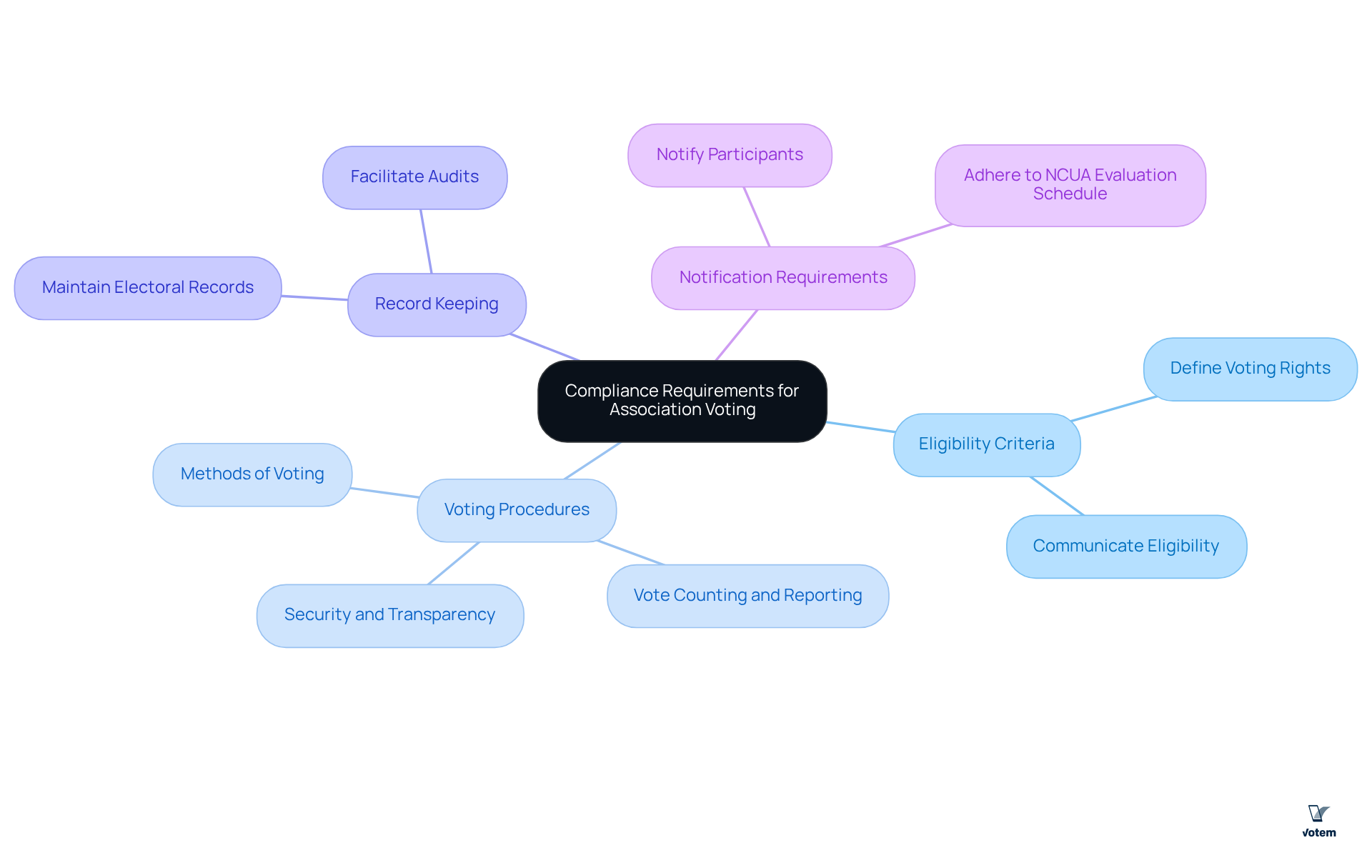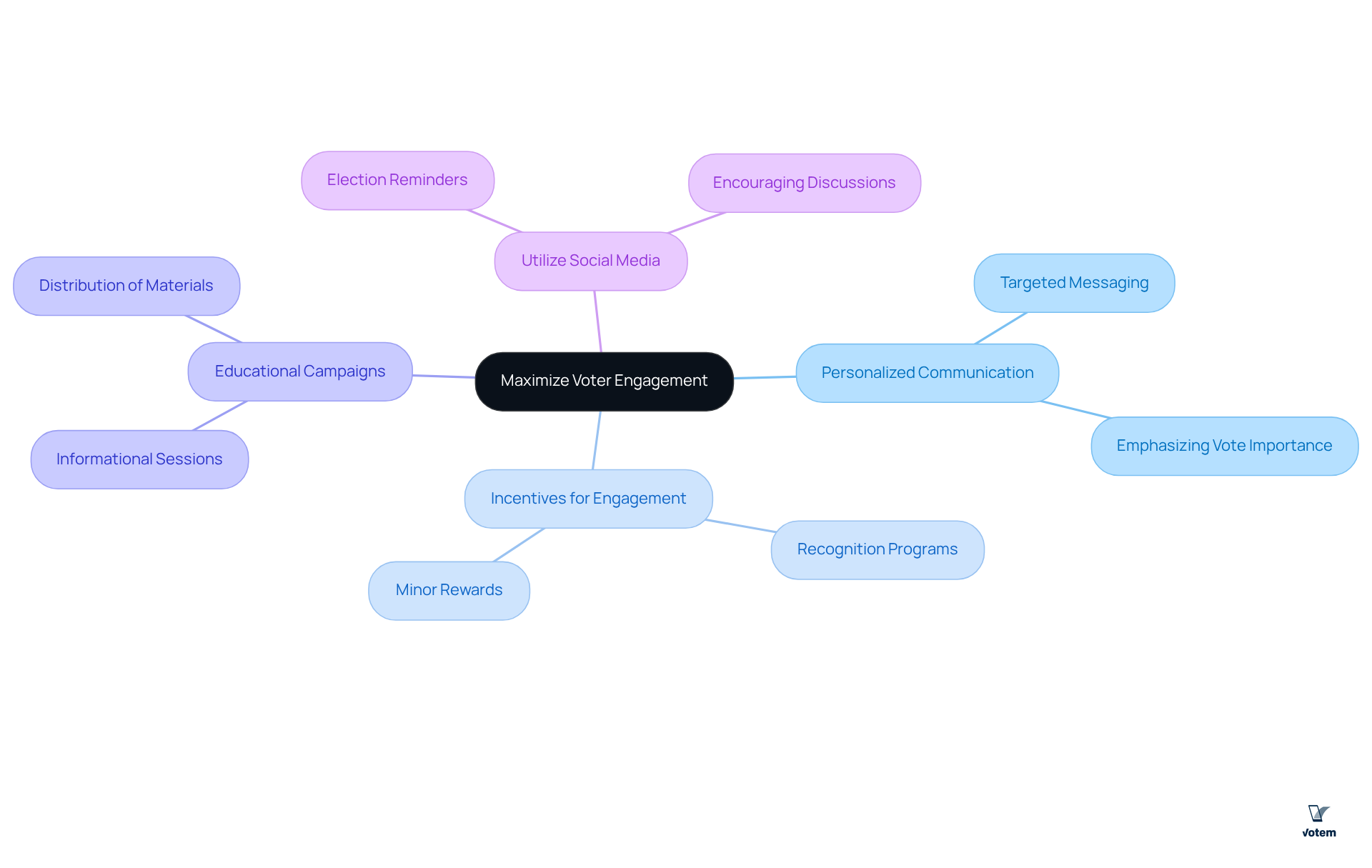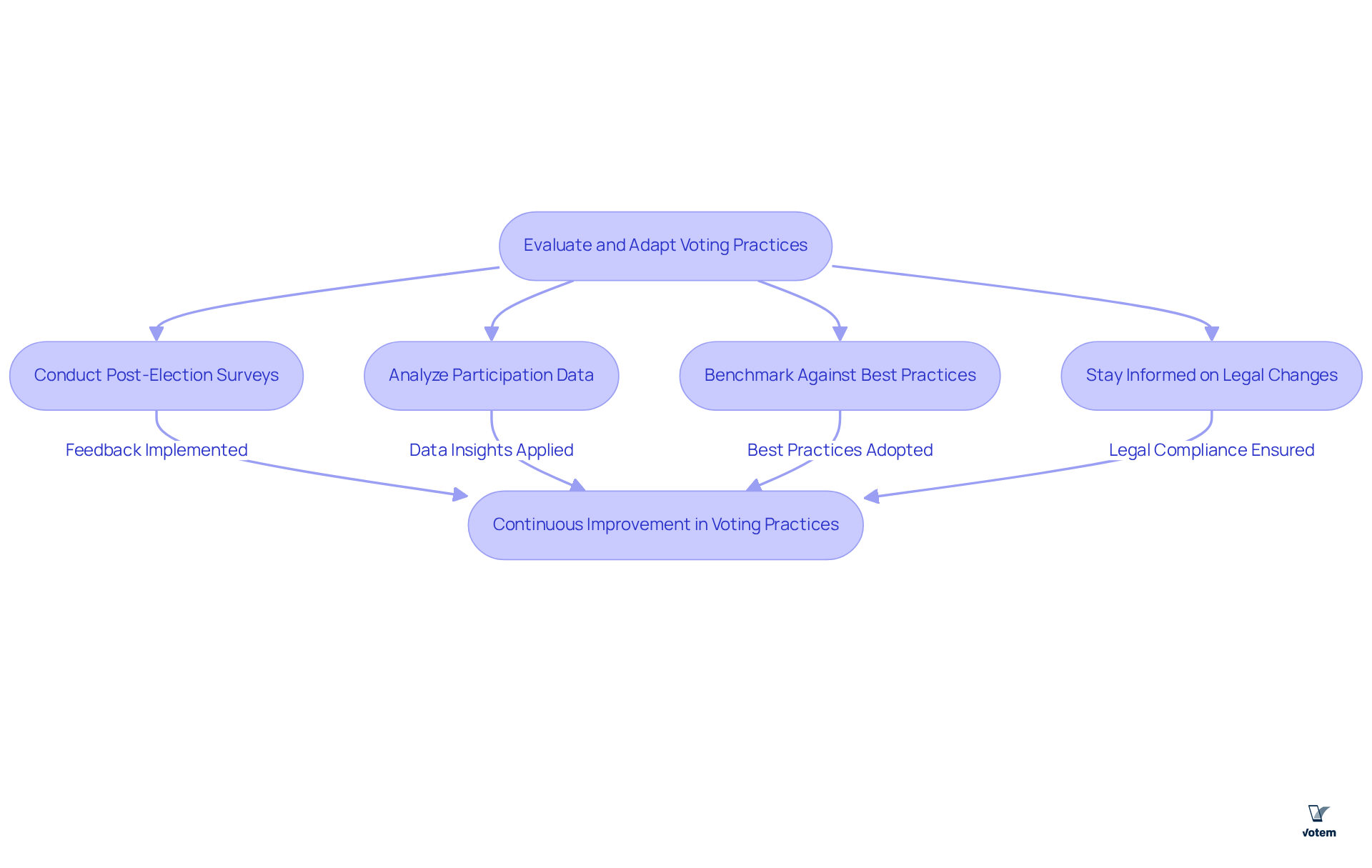Overview
This article presents four strategies designed to enhance voter engagement in association voting, underscoring the critical role of compliance, technology, and continuous improvement. By implementing these strategies, union leadership can significantly increase participation and foster trust in the electoral process.
Firstly, personalized communication stands out as a vital practice. Tailoring messages to individual voters not only captures their attention but also builds a connection that encourages engagement. Furthermore, secure voting platforms are essential in ensuring that voters feel safe and confident in casting their ballots. These platforms must be user-friendly and reliable to facilitate a smooth voting experience.
In addition, post-election evaluations play a crucial role in the continuous improvement of voter engagement strategies. By analyzing the outcomes and gathering feedback, unions can identify areas for enhancement and adapt their approaches accordingly. This commitment to ongoing assessment demonstrates a dedication to evolving practices that meet the needs of the electorate.
In conclusion, these strategies collectively aim to increase participation and build trust in the electoral process. Union leadership is encouraged to adopt these practices to not only enhance voter engagement but also to ensure a more robust and transparent electoral environment.
Introduction
Navigating the complex landscape of association voting presents a significant challenge for many organizations. Legal compliance, voter engagement, and technological advancements are critical factors that associations must consider. This landscape offers a unique opportunity for associations to enhance their electoral processes.
How can they effectively mobilize their members to ensure a secure, transparent voting experience? This article explores four essential strategies that not only meet compliance requirements but also foster greater participation and trust among members. Ultimately, these strategies contribute to a more robust democratic process within associations.
Understand Compliance Requirements for Association Voting
Associations must thoroughly comprehend the legal structures that regulate their election procedures, particularly the stipulations established by the National Credit Union Administration (NCUA), the Department of Labor (DOL), and the Employee Retirement Income Security Act (ERISA). Key compliance aspects include:
- Eligibility Criteria: Clearly define and communicate who is eligible to vote, ensuring all members are aware of their voting rights.
- Voting Procedures: Establish clear methods explaining how votes are cast, counted, and reported, fostering trust in the electoral system. Votem’s commitment to enhances voter confidence, making it a preferred choice for organizations.
- Record Keeping: Maintain meticulous records of all electoral activities, including ballots and results, to facilitate audits and compliance checks, which are essential for regulatory adherence. Votem has successfully managed over 13 million votes, demonstrating its capability to handle large volumes of ballots efficiently.
- Notification Requirements: Adhere to notification duties concerning upcoming votes, guaranteeing that all participants receive prompt information about the voting procedure. The NCUA’s regulatory evaluation every three years underscores the significance of remaining informed about compliance requirements.
By prioritizing these compliance strategies, organizations can mitigate legal risks and strengthen participant confidence in their electoral processes. Legal specialists emphasize that compliance with these frameworks is essential for upholding trust and integrity in group decision-making.

Implement Strategies to Maximize Voter Engagement
To enhance , associations must implement effective strategies that resonate with their members through associationvoting.
- Personalized Communication is crucial; targeted messaging should be employed to reach out to members, emphasizing the significance of their vote and its impact on the organization. This approach not only informs but also empowers members to take action through associationvoting.
- Incentives for Engagement can further motivate participation. By providing recognition or minor rewards to individuals who engage in the selection process, associations can create a culture of appreciation and involvement.
- Educational Campaigns are essential for informing members about the electoral process. Holding informational sessions or distributing materials that elucidate the importance of the election and how members can voice their opinions fosters a knowledgeable electorate.
- Utilize Social Media effectively to create excitement around the election. By leveraging platforms to share reminders and encourage discussions about candidates or issues at stake, associations can amplify their outreach.
Implementing these strategies will not only significantly increase voter turnout but also cultivate a robust culture of participation within the associationvoting.

Utilize Technology for Secure and Efficient Voting Processes
Incorporating association voting technology into the election system can significantly enhance both security and efficiency. To achieve this, consider the following best practices:
- Choose a Secure Voting Platform: Opt for a platform that adheres to industry standards, such as AES-256 encryption, and offers an immutable audit trail to ensure the integrity of the voting process. Mobile accessibility is essential; prioritize a mobile-friendly platform that enables members to easily participate in association voting from their devices. Votem’s is specifically designed to enhance association voting, leading to a remarkable increase in participation rates. Studies indicate that mobile accessibility can boost turnout by up to three times on launch day.
- Real-Time Monitoring: Implement features that enable real-time tracking of voter participation, such as Votem’s real-time quorum meter. This tool helps reduce last-minute reminder calls, allowing organizations to quickly recognize and resolve any issues, thereby ensuring a smoother electoral experience.
- Post-Election Analysis: Utilize technology to examine electoral data after elections. Votem’s experience managing over 13 million votes provides valuable insights into voter behavior and highlights areas for improvement in future electoral processes.
By harnessing technology, organizations can promote a more secure and user-friendly electoral experience with association voting, ultimately encouraging increased participant involvement.

Evaluate and Adapt Voting Practices for Continuous Improvement
To ensure continuous improvement in voting practices, associations must take decisive actions:
- Conduct Post-Election Surveys: It is imperative to gather feedback from members regarding their voting experiences. Identifying challenges and suggestions for improvement in association voting can yield actionable insights that enhance future elections. This proactive approach not only addresses concerns but also fosters a culture of association voting and responsiveness.
- Analyze Participation Data: A thorough review of voter turnout statistics and engagement metrics is essential to understanding trends and pinpointing areas that require attention. For instance, the 2024 election achieved a 64% turnout rate, marking the second highest since 1960. Such increasing involvement should be leveraged to refine future electoral initiatives within groups.
- Benchmark Against Best Practices: Organizations should compare their electoral practices with those of similar entities to uncover potential enhancements. This includes examining successful strategies employed by organizations that have significantly boosted voter turnout, such as those utilizing mobile-first platforms like Votem’s CastIron, which can increase participation by up to three times on launch day.
- Stay Informed on Legal Changes: Regularly reviewing and updating election procedures to comply with any changes in legislation or industry standards is crucial. Recent legal developments, particularly those influencing election supervision, can significantly impact how groups conduct their electoral activities.
By committing to ongoing evaluation and adaptation, associations can cultivate a more inclusive and effective association voting environment that meets the needs of their members. This commitment ultimately enhances participation and builds trust in the electoral process.

Conclusion
Effective association voting engagement is paramount in cultivating a vibrant and participatory organizational culture. By grasping compliance requirements, executing strategic outreach, leveraging technology, and committing to continuous improvement, associations can significantly elevate voter participation and guarantee a transparent electoral process.
The article delineates four essential strategies:
- Associations must prioritize compliance with legal frameworks to uphold trust and integrity in their voting systems.
- Personalized communication and incentives can empower members, while educational campaigns and social media outreach can further amplify engagement.
- Leveraging technology not only secures the voting process but also streamlines participation through user-friendly platforms.
- Ongoing evaluation and adaptation of voting practices are crucial for addressing challenges and enhancing future elections.
In conclusion, the significance of effective association voting engagement cannot be overstated. By embracing these best practices, organizations can foster a more informed and involved membership, ultimately leading to stronger decision-making and a more robust community. It is essential for associations to adopt these strategies, ensuring that every member’s voice is heard and valued in the electoral process.
Frequently Asked Questions
What are the key compliance requirements for association voting?
Key compliance requirements include understanding eligibility criteria, establishing clear voting procedures, maintaining meticulous record-keeping, and adhering to notification requirements.
How should associations define eligibility criteria for voting?
Associations must clearly define and communicate who is eligible to vote, ensuring that all members are aware of their voting rights.
What should associations establish regarding voting procedures?
Associations should establish clear methods for how votes are cast, counted, and reported to foster trust in the electoral system.
Why is record keeping important in association voting?
Maintaining meticulous records of all electoral activities, including ballots and results, is essential for facilitating audits, compliance checks, and regulatory adherence.
What role does Votem play in the voting process?
Votem enhances voter confidence through its commitment to security and transparency, having successfully managed over 13 million votes efficiently.
What are the notification requirements for associations regarding voting?
Associations must adhere to notification duties to ensure all participants receive prompt information about upcoming votes and the voting procedure.
How often does the NCUA evaluate compliance requirements?
The NCUA conducts a regulatory evaluation every three years to underscore the importance of remaining informed about compliance requirements.
Why is compliance with these frameworks essential for organizations?
Compliance is essential for mitigating legal risks and strengthening participant confidence in electoral processes, upholding trust and integrity in group decision-making.
List of Sources
- Understand Compliance Requirements for Association Voting
- NCUA Regulatory Review: Public Comment Opportunity – MD|DC Credit Union Association (https://mddccua.org/2025/06/ncua-regulatory-review-public-comment-opportunity)
- Credit Union Compliance Roadmap | NAFCU (https://nafcu.org/roadmap)
- NCUA should focus on FOM reforms, additional regulatory relief (https://americascreditunions.org/news-media/news/ncua-should-focus-fom-reforms-additional-regulatory-relief)
- ncua.gov (https://ncua.gov/regulation-supervision/letters-credit-unions-other-guidance/ncuas-2025-supervisory-priorities)
- Implement Strategies to Maximize Voter Engagement
- Get Out the Vote: Cultivating Civic Engagement in Youth and Adults (https://aamchealthjustice.org/news/polling/get-out-vote)
- Increase Voter Engagement This Year for Better Turnout in 2024 | Granicus (https://granicus.com/blog/increase-voter-engagement-this-year-for-better-turnout-in-2024)
- 10 Strategies: Boost Voter Turnout in Local Elections | Blog (https://granicus.com/blog/10-strategies-to-boost-voter-turnout-and-engagement-in-local-elections)
- Reframing voting as ‘duty to others’ key to increasing engagement, turnout | WashU Olin Business School (https://olin.washu.edu/about/news-and-media/news/2024/06/reframing-voting-as-duty-to-others-key-to-increasing-engagement-turnout.php)
- Fostering Voter Engagement in 2024 (https://minneapolisfoundation.org/stories/civic-engagement/fostering-voter-engagement-in-2024)
- Utilize Technology for Secure and Efficient Voting Processes
- The Most Popular Free Encryption Software Tools [Updated 2025] (https://heimdalsecurity.com/blog/free-encryption-software-tools)
- Secure Online Voting System in the Cloud – ElectionBuddy (https://electionbuddy.com/blog/2024/08/21/safe-and-secure-online-election)
- stateline.org (https://stateline.org/2021/02/17/despite-security-concerns-online-voting-advances)
- West Virginia Becomes First State to Test Mobile Voting by Blockchain in a Federal Election (https://govtech.com/biz/West-Virginia-Becomes-First-State-to-Test-Mobile-Voting-by-Blockchain-in-a-Federal-Election.html)
- Evaluate and Adapt Voting Practices for Continuous Improvement
- JWS Research post federal election survey report (https://jwsresearch.com/jws-research-post-federal-election-survey-report)
- Exit Surveys: Voters Love Ranked Choice Voting – FairVote (https://fairvote.org/report/exit-surveys-report-2025)
- Groups Working to Inform and Empower Voters in 2024 – National Civic League (https://nationalcivicleague.org/groups-working-to-inform-and-empower-voters-in-2024)
- pewresearch.org (https://pewresearch.org/politics/2025/06/26/behind-trumps-2024-victory-a-more-racially-and-ethnically-diverse-voter-coalition)
- Local Election Officials Survey — July 2025 (https://brennancenter.org/our-work/research-reports/local-election-officials-survey-july-2025)

